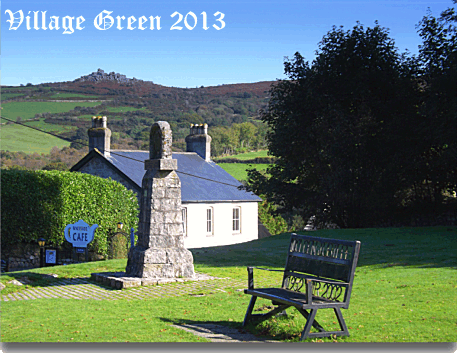
If you visit Widecombe in the Moor the chances are that the first thing you will come across is the village green with it’s metal bench and what is probably the most famous of Dartmoor’s village signs. I would suggest that the majority of tourists will take home a photograph or postcard of the sturdy granite monument as a memento of their visit. There can be nothing more peaceful than to sit on the bench and admire the tor studded landscape that acts as a backdrop to the green.

Mind you, back through the mists of time this green would have not been such a tranquil place, in fact it would have been a dangerous place to linger. It is considered that this particular piece of land was once known as Henhay or Butte Parks and the rents for it were spent on, ‘charitable and good uses‘ of the parishioners, Dymond, p.57. The word Butte derives from the Anglo French word Bouter which roughly translated means to ‘expel’ and in this case it refers to arrows. Originally the term butt referred to an earthen target at which arrows were aimed, in later years the Butt or Butte indicated the actual land where archery practice was held. Prior to the use of firearms in warfare the mainstay of any army was the war bow. Therefore it was essential that there was a constant source of proficient archers who could, when needed, be called upon to do their bit for king and country. To ensure this an act was passed in 1252 called the Assize of Arms Law, this decreed that every male between the ages of 15 and 60 equipped themselves with a bow and arrows. In 1363 another law was passed which compelled all males falling in the 15 – 60 year old bracket to practice their archery skills on every Sunday and Feast Day. Additionally the law forbade, on pain of death, the participation of any other sport or pastime that interfered with the archery practice. In the case of Widecombe Dymond, p.57 elaborates further; “There can be, we imagine, little doubt but that this piece of land was originally provided for the use of the inhabitants of the parish in obedience to an Act passed in the fifth year of Edward II (A.D. 1466), which directed “That every Englishman should have a bow of his own height of yew, ash, wych, hazel or amburn; and that butts should be made in every township, which the inhabitants were to shoot at every feast-day under the penalty of a halfpenny when they should omit that exercise.” There was even a law passed which stated that a murder charge could not be brought against any archer who accidentally killed someone whilst at the butts.
We now can leap forward to the famous village sign/monument and the year 1920, in this year the Daily Mail held a competition to design a village sign and one Mr. C. Churchward’s idea won him £50 for Widecombe’s. The sign was made from local granite and depicted Old Tom Cobley’s mare astride which were all his infamous companions. At the top of the column the name of Widecombe in the Moor was placed in gold letters. The sign was unveiled by the chairman of Newton Abbot Rural Council, one Charles Stooke. As part of the ceremony two villagers, Mr. C. Churchward and Mr.F. Gough, sang the famous folk song ‘Widecombe Fair’, WDLHG, p.41. Incidentally, this was the first village sign to be erected in the whole of Devonshire, a fact that has not gone unnoticed as a plaque on the pillar testified. It read; “Following a speech by his Royal Highness The Duke of York at the Royal Academy in 1920 on the revival of Village Signs. The Daily Mail organised a Village Signs Competition and Exhibition offering a total of £2200 in prizes. Ten awards were made and the design from which this sign was constructed secured special prize £50.” WDLHG – online source HERE.
During the Second World War there was a real threat of invasion and so in order to ‘confuse’ any would-be invaders the government decreed that all village signs, signposts and milestones were removed. This included Widecombe’s village sign which unfortunately whilst being dismantled was dropped and damaged beyond repair. After the war it was decided that a new village sign should be erected. Thanks to the generosity of Mr. F. Hamlyn of nearby Dunstone Court the funding was found, and then Lady Sylvia Sayer came up with a new design. A plaque was placed on the column of the sign which reads; “This sign was presented to the Parish of Widecombe-in-the-Moor by Francis Hamlyn Esquire of Dunstone Court, Widecombe 1948.” Along with a different design came a different location for the village sign, this time it was erected opposite its old site on the village green or Butte Park where it stands today.

Sadly, a combination of the moorland weather and a thriving community of lichens Widecombe’s village sign is becoming rather timeworn and weary. As can be seen from the postcard images opposite it is now hard to discern old Tom Cobley and his ensemble compared to how they were in all their glory. It does seem a shame that such an iconic feature such as this be allowed to degenerate into such a condition. Maybe one day should funds allow somebody will give it a face lift

Dymond, Rev. R. 1876. Things New and Old Concerning the Parish of Widecombe-in -the-Moor. Torquay: The Torquay Directory Company.
Widecombe and District Local History Group. 2007. The History of Widecombe Fair. Crediton: Hedgerow Print.
 Legendary Dartmoor The many aspects past and present of Dartmoor
Legendary Dartmoor The many aspects past and present of Dartmoor
